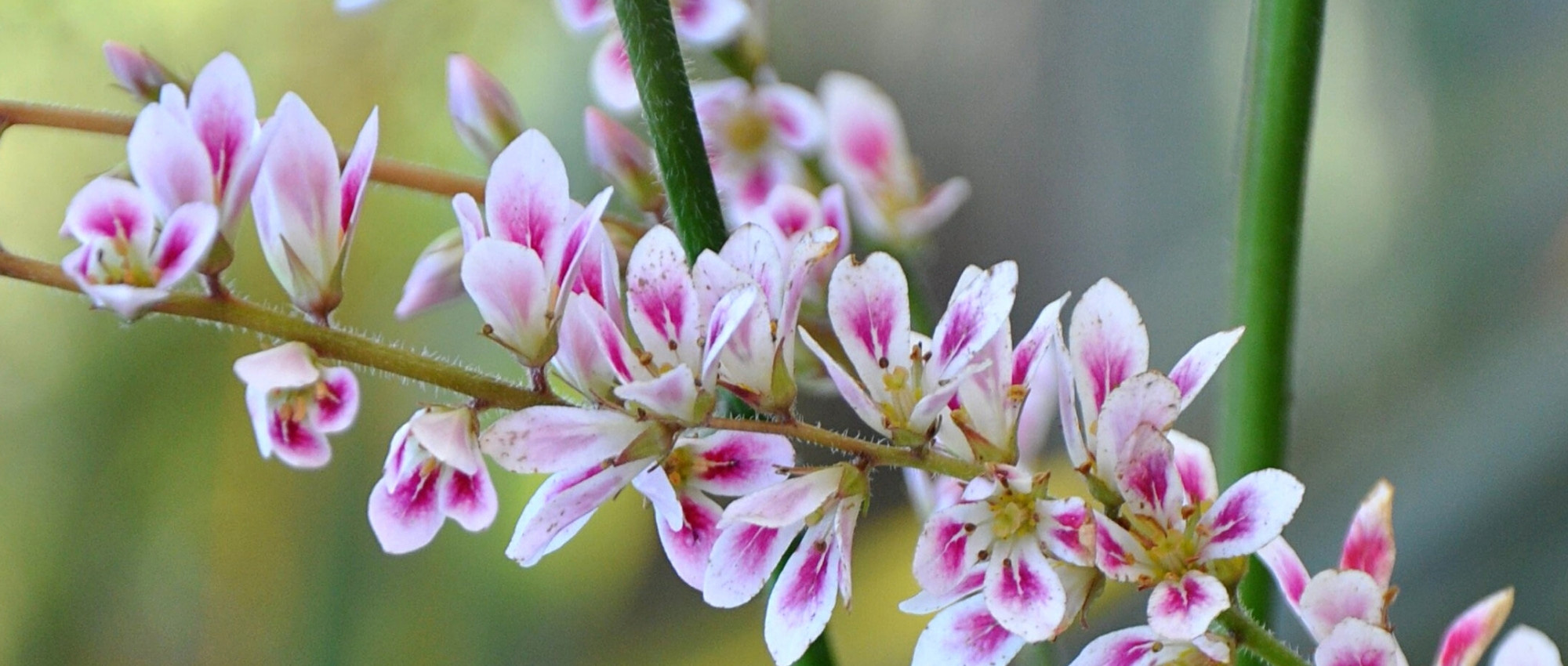
Francoa: planting, growing and care
Contents
Francoa in a nutshell
- Francoa is a very original and little-known Chilean perennial that truly deserves its place in the garden!
- It bears long clusters of light pink flowers speckled with dark pink – red at the beginning of summer.
- It thrives in partial shade in humus-bearing, cool, and well-draining soil.
- Its very delicate flowering allows it to be easily integrated into a romantic garden.
- It will also find its place in a partially shaded rockery, a naturalistic garden, or a mixed border.
A word from our expert
Francoa is a stunning Chilean perennial native to the Andes, unfortunately still little known, and rarely cultivated. There are three species: Francoa sonchifolia, Francoa appendiculata, and Francoa ramosa. They produce long clusters of white or soft pink flowers in early summer, rising above their foliage. These consist of four petals arranged in a cross, maculate with dark pink. Their flowering is very light, delicate, and romantic! We also appreciate their dark green, fuzzy leaves with undulating edges, which are evergreen.
Francoa thrives in partial shade or in non-burning sunlight, in rich, cool, but well-drained soil. It is sensitive to soils that remain damp in winter. Francoa is hardy down to -10 °C. Integrate it into a mixed border with summer-flowering perennials, in a cool rockery, or in a romantic-style garden. It also adapts well to pot cultivation, for example, to enhance a terrace or balcony. Discover in this guide all our tips for successful cultivation: which variety to choose, where and how to plant it, how to care for it, and which plants to associate with it in the garden!
Botany
Botanical data
- Latin name Francoa sp.
- Family Melianthaceae
- Common name Francoa
- Flowering in June-July, sometimes until September
- Height between 50 cm and 1 m
- Exposure partial shade, non-burning sun
- Soil type rich and cool, well-draining
- Hardiness down to -10 °C
Francoa are herbaceous perennial plants native to Chile, where they are endemic (it is the only place where they are naturally found). They primarily grow in mountainous regions, in the Andes, on cliffs and in rocky crevices. There are only three species, which are very similar: Francoa sonchifolia, Francoa ramosa, and Francoa appendiculata. Despite their beautiful ornamental qualities, these plants are little known and rarely seen in gardens.
Francoa belong to the botanical family Melianthaceae. This is a small family, consisting of only four genera: Melianthus, Greyia, Bersama, and Francoa. They are shrubs or small trees with alternate leaves and irregular flowers with five petals (sometimes four), mainly native to tropical and subtropical regions of Africa.
Regarding their hardiness, Francoa can withstand temperatures down to -10 °C when grown in well-drained soil that does not retain water in winter.
Francoa form a clump of basal leaves close to the ground, from which upright flowering stems emerge in early summer. They measure between 50 cm and 1 m tall, with a spread of 30-40 cm. The largest is Francoa ‘Pink Giant’, which easily reaches 90 cm to 1 m in height. There is also a dwarf variety: ‘Petite bouquet’, which does not exceed 45-50 cm in height.
Francoa produce rosettes of basal leaves with undulating edges. These leaves measure 5 to 15 cm long and consist of several small rounded lobes and one large terminal lobe. They have a beautiful dark green colour and are fuzzy. The leaves are quite characteristic, with soft and slightly irregular shapes, providing a lovely backdrop for their refined flowers.
The leaves of Francoa are evergreen: the plant retains them in winter, despite the cold.

The foliage of Francoa appendiculata and Francoa ramosa (photos: Daderot / Stan Shebs)
Francoa flowers in early summer, usually in June-July (depending on the climate, flowering can even extend until August or September). At this time, it produces upright, unbranched stems bearing compact terminal flower clusters. The flower buds are dark pink, then open into lovely small pink flowers, measuring 1 to 2 cm in diameter. These flowers consist of four pale pink petals arranged in a cross, marked at the centre with dark pink-red spots that add intensity and depth to the flowering. These spots form comma-like shapes starting from the centre of the flower, at the base of the petals. Francoa ramosa is distinguished from the other species by its white flowers marked with pink spots and its branched flower stems. There is also a variety with dark pink flowers: ‘Rogerson’s Form’.
The flowers of Francoa are appreciated for their very delicate and romantic style, light in appearance. They evoke butterfly wings, and their upright mauve clusters can resemble wild orchids. The flowers are not fragrant.

The floral clusters of Francoa sonchifolia and Francoa appendiculata, and a detail of the flowers of Francoa sonchifolia
Carried by a long upright stem and gathered in generous inflorescences, the flowers of Francoa are perfect for creating bouquets! They have good vase life and are very romantic. They integrate very well into wedding bouquets (Francoa is indeed nicknamed in English Bridal wreath).
Read also
Planting Perennials and BushesThe main varieties of Francoa
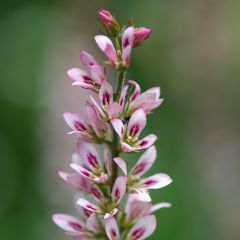
Francoa sonchifolia
- Flowering time July, August
- Height at maturity 45 cm
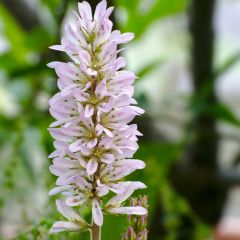
Francoa appendiculata
- Flowering time February
- Height at maturity 60 cm
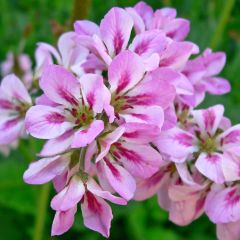
Francoa ramosa
- Flowering time July, August
- Height at maturity 40 cm
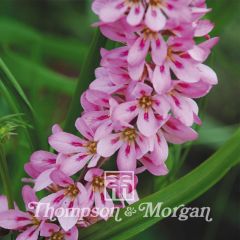
Francoa sonchifolia Pink Giant Seeds
- Flowering time August, September
- Height at maturity 90 cm
Discover other Francoa
View all →Available in 1 sizes
Available in 1 sizes
Available in 1 sizes
Planting
Where to plant Francoa?
Francoa thrives in partial shade or in non-burning sunlight. In warm regions, such as the Mediterranean basin, it is better to place it in partial shade and ensure it is protected from direct sunlight during the afternoon, while in northern France, it will enjoy full sun. Francoa prefers fertile soils rich in humus that remain relatively cool in spring and summer, but well-drained, without stagnant moisture in winter, as this could cause rot. Francoa does not seem particularly sensitive to pH, tolerating acidic, neutral, or calcareous soils.
Francoa can withstand temperatures down to -10 °C if the soil is dry. In wet conditions, it is more susceptible to cold, highlighting the importance of growing it in well-drained soil. Similarly, choose a location sheltered from cold winds.
You can plant it at the edge of a border, along a path, in a perennial or annual bed. It will also fit well in a cool rock garden. Its delicate flowers will easily blend into a romantic garden. If you are planting multiple young plants, maintain a distance of 30 to 40 cm between them.
It is also possible to grow Francoa in a pot. This allows you to bring it indoors in autumn to protect it from cold and moisture.
When to plant?
The best time to plant Francoa is in spring, during April-May.
How to plant?
For planting in the ground:
- Find a partially shaded location, sheltered from cold winds.
- Dig a planting hole two to three times the size of the root ball.
- Add well-decomposed compost to enrich the soil, and optionally a bit of gravel or coarse sand, which you will mix with the soil to improve drainage.
- Remove Francoa from its pot and place it in the centre of the planting hole.
- Fill in around it with soil, ensuring not to bury its collar.
- Gently firm the soil to ensure good contact between the substrate and the roots.
- Water generously.
- You may add a layer of mulch around the clump to keep the soil cool for longer.
For planting in a pot:
- Choose a pot with drainage holes.
- Add potting soil to the pot.
- Carefully remove Francoa from its original pot, lightly scratch the root ball to remove some soil and loosen the roots, then place Francoa in the centre of the pot.
- Fill in around it with more potting soil, ensuring not to bury the collar.
- Lightly firm the soil to ensure good contact between the roots and the potting soil, and to avoid air pockets.
- Water.
- Place the pot, for example, on your terrace or balcony, in a bright spot but sheltered from burning sunlight.
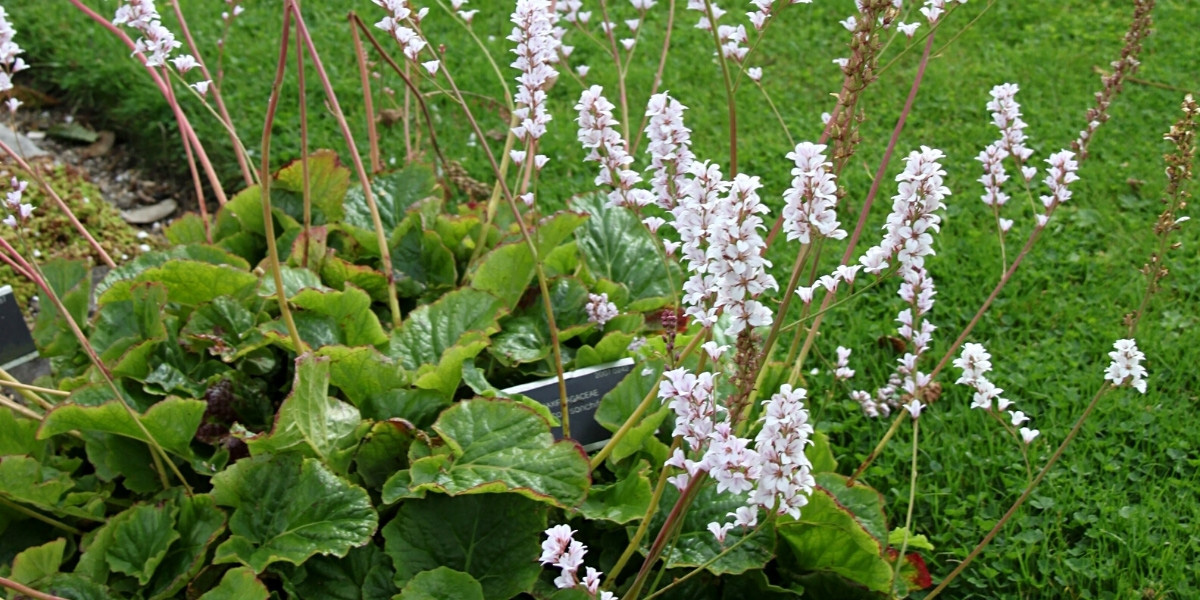
Francoa sonchifolia
Care
Francoa is not very susceptible to diseases and pests, and requires little maintenance. However, be vigilant during the first few years regarding cold and drought, until it is well established. After that, it will become more resilient.
We recommend that, at least during the first few years, you place dead leaves between the leaves and on the ground around the base in autumn as mulch. This layer will protect the stump from the cold. The mulch will also help to keep the soil cool for longer and limit the growth of adventive plants.
If you are growing it in a pot, remember to water it regularly, as the substrate dries out more quickly than in open ground! Reduce watering in autumn and winter. We also advise providing a bit of fertiliser, about once a month from spring to autumn.
Multiplication
It is possible to propagate Francoa by sowing or division of clumps. Division is quicker and easier to succeed, but it requires already having well-developed young plants, while sowing allows for obtaining a greater number of young plants without disturbing the original plant.
Sowing
To germinate, the seeds need to be stratified: place them in the refrigerator for 3 weeks before sowing. This helps break dormancy and promotes germination.
- When the seeds are ready to be sown, prepare a pot with special sowing soil.
- Lightly firm and level the surface.
- Place the seeds on the surface.
- Cover them with a thin layer of soil.
- Water gently, using a fine spray.
- Place the pot in a bright location, out of direct sunlight. Ideally, the temperature should be between 17 and 24 °C.
The seeds take between 2 weeks and 1 month to germinate. Remember to water occasionally to keep the substrate slightly moist until germination. As soon as they reach a size that allows for handling, repot the seedlings into individual pots.
Division of clumps
It is also possible to divide clumps of Francoa. The best time to do this is in spring, during April-May. Identify a well-developed clump that is several years old, then carefully dig around it to lift it without damaging the roots too much. Separate it into several young plants, then replant them and water.
Association
The delicate flowers of Francoa, a soft pink beautifully shaded with dark pink, integrate very easily into a romantic-style garden. Create an intimate atmosphere in your garden by pairing it with other perennials that have very soft flowering. Opt for shades of pink, white, and mauve, alongside the flowering of astrantias, hardy geraniums, foxgloves, hollyhocks, gypsophilas, lupins… not forgetting, of course, the roses! Feel free to incorporate a few plants with silver foliage, such as wormwoods or Stachys byzantina. You can also set up a small garden lounge, inviting you to sit and enjoy this enchanting setting, sheltered under a pergola where, for example, a rose or a clematis could climb.
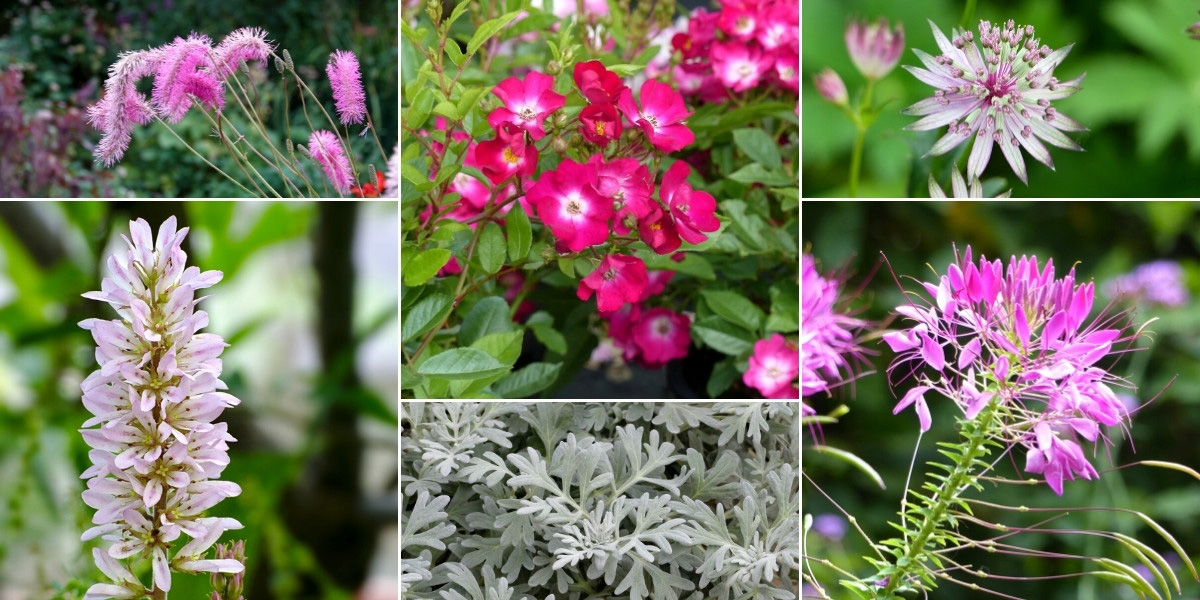
Feel free to integrate Francoa into a romantic-style flowerbed, with blooms in very soft shades. Here, Sanguisorba obtusa, Rose ‘Red Ballerina’, Astrantia major ‘Ruby Star’, Francoa appendiculata, Artemisia stelleriana ‘Silver Brocade’ and Cleome ‘Violet Queen’
As it grows spontaneously in rocky environments and appreciates well-drained soils, Francoa will naturally find its place in a semi-shaded rockery. Create a small raised flowerbed, for example on an existing slope or bank, and incorporate large stones to help hold the soil in place. Then, place Francoa between the stones, accompanied by saxifrages, tiarellas, gentians, Alpine lady’s mantle, androsaces… and a few ferns like polypody or the unique Coniogramme emeiensis!
Finally, with its very light and airy flowering, Francoa is ideal in a naturalistic-style garden! Place it alongside perennials with a free and flexible, natural silhouette: gaura, Buenos Aires verbena, scabious, penstemons, Allium sphaerocephalon… or the impressive Cephalaria gigantea, a giant scabious that can reach up to 2 metres tall. Don’t forget the grasses, such as Stipa tenuifolia or Pennisetums. They will give your garden a true wild meadow feel!
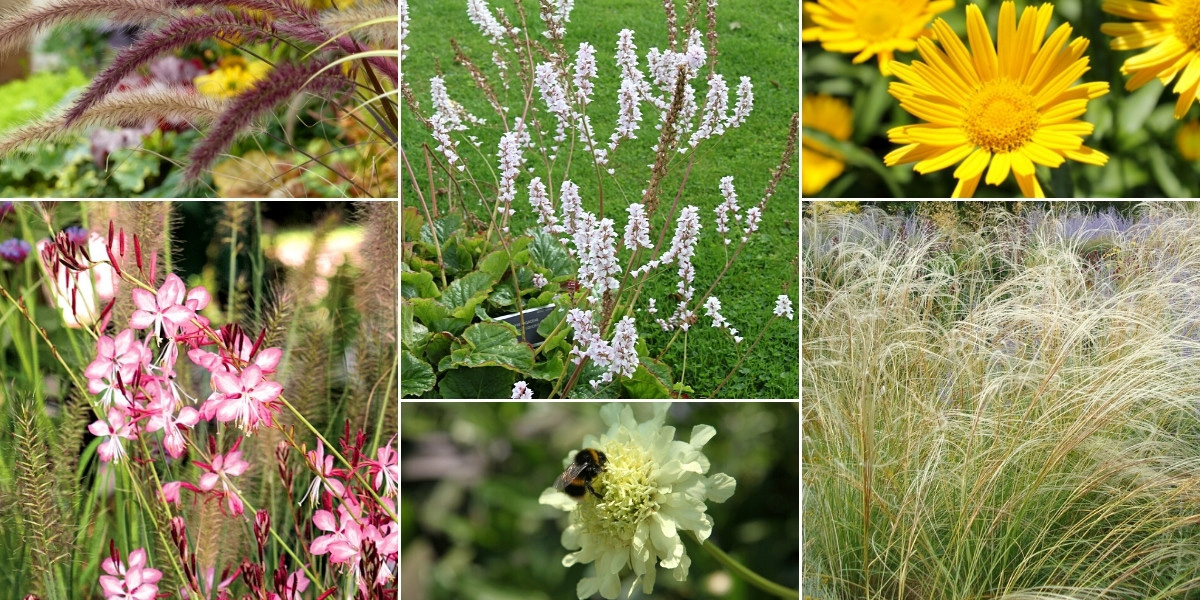
Francoa will easily find its place in a naturalistic garden! Pennisetum setaceum ‘Rubrum’, Francoa sonchifolia, Buphtalmum salicifolium ‘Alpen Gold’ (photo C.T. Johansson), Gaura ‘Rosy Jane’, Cephalaria gigantea and Stipa barbata
→ Discover more ideas to pair Francoa with in our article.
Useful resources
- Discover our range of Francoa
- All our tips for creating a rockery
- To accompany Francoa, discover our range of perennials for a romantic garden, for a cottage garden or for a rockery
- Subscribe!
- Contents


































Comments